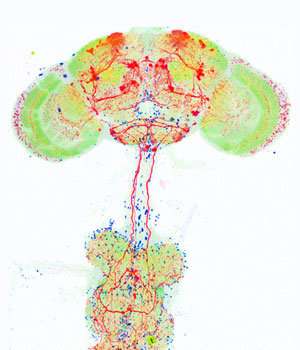Small molecule protects the nervous system's support cells from excessive stimulation

Glutamate is the primary excitatory neurotransmitter of the central nervous system, in excess it causes cells to become overexcited, which contributes to neuron death in neurodegenerative disease. Now, a study of flies led by Sherry Aw, at the A*STAR Institute of Molecular and Cell Biology, highlights the importance of also curbing glutamate stimulation in glia. Glia are generally considered the nervous system's support cells, although important contributions to brain signaling have also recently been described.
Although glia account for 90 per cent of the cells in the human brain, research on the molecular mechanisms of neurodegenerative disease mainly focus on neurons. In their article in Cell Reports, Aw and colleagues show that a small RNA that regulates glutamate receptor expression in glia, mir-263a, protects flies from developing a movement defect associated with neurodegeneration.
Flies lacking the gene encoding mir-263a were unable to climb up the walls of a cylindrical vial when flipped from a horizontal to vertical position. The climbing defect worsened with age, reflecting a progressive decline in nervous system function. The authors were surprised when they examined the expression pattern of mir-263a as they found that it is predominantly expressed and functional in glia, rather than in neurons.
They found that mir-263a depletion triggers glial cell death and that restoring mir-263a expression in a subset of glia not only promotes cell survival, but remedies the flies' impaired climbing.
Mir-263a is a small non-coding RNA molecule (microRNA) that suppresses the expression of multiple target genes. In the brain of mir-263a mutant flies, the authors detected an increase in the expression of over 70 genes, including several encoding for glutamate receptors. When the authors reduced the expression levels of these receptors in glia of flies lacking mir-263a, glia cell numbers were restored and the movement defects were suppressed. "MicroRNAs can be an efficient mode of gene regulation as a single microRNA can target a family of genes with a similar molecular function" explains Aw.
Previous studies have shown that glia express all the major types of glutamate receptors and that they contribute to maintain neuronal function by clearing extracellular glutamate, but little is known about the effects of glutamate on glia themselves. This study shows that glia, like neurons, are susceptible to glutamate overstimulation, and highlights a key role for mir-263a in fine-tuning the levels of glutamate receptor expression in glia and thus, their sensitivity to the neurotransmitter.
It will be interesting to determine whether a similar mechanism contributes to neurodegenerative diseases in humans and to explore the exciting possibility of developing microRNA-based therapeutics to treat them, says Aw.
More information: Sherry Shiying Aw et al. A Glio-Protective Role of mir-263a by Tuning Sensitivity to Glutamate, Cell Reports (2017). DOI: 10.1016/j.celrep.2017.05.010



















